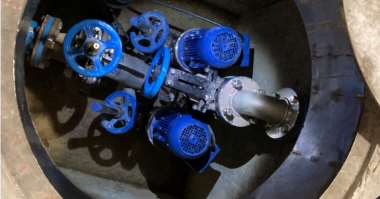Did you know that the instrumentation technician is a better friend to the Pump Reliability Engineer, than the vibration analyzer or the Computerized Maintenance Management program? I believe this to be true. Let me explain …
Pumps-mated-to-electric-motors are the most popular piece of industrial equipment in the world. Most instrumentation is installed onto equipment fed by pumps. Sometimes a process engineer wants to know the fluid velocity, flow, or pressure in a pipe. A pump normally generates that velocity, flow, and pressure. And sometimes the pump contributes to the temperature in a chemical process. When the temperature, velocity, flow, and pressure are not what they should be, it normally indicates that the pump is in stress and headed for failure. And folks, that’s why the instrumentation tech is reliability’s friend.
The industrial pump is a relatively simple device when compared to a V-8 engine or a refrigerator. Pumps are only slightly more complicated than a butter knife. The shaft and impeller assembly is the only moving part. And most of what we call “pump problems” actually originate outside the pump.
Let’s consider pumps and gauges. Pump manufacturers use the term “head” in feet for fluid force. Maintenance people use the term pressure in PSI for fluid force. The conversion factor 2.31 separates the two terms.
For water, head divided by 2.31 is pressure, and pressure multiplied by 2.31 is head. If the liquid is not ambient water, then the liquid’s specific gravity (sp.gr.) must be factored into the formula.
[Head (ft.) / 2.31] x sp.gr. = PSI
[PSI x 2.31] / sp.gr. = Head in ft.
For example, most communities have an elevated water tank that supplies water pressure to the neighborhoods below the tank. Let’s say the level of water in the tank is 200 feet above a kitchen faucet in one of the homes. What is the water pressure at the faucet? 200 ft./2.31 = 86.6 PSI.
There would be about 87 PSI of water pressure at the kitchen faucet because the water in the supply tank is 200 feet high. Let’s say a pump is designed to develop 70 feet of head. 70 ft./2.31 = 30 PSI. There should be 30 PSI of differential pressure across this pump. This means if the suction pressure gauge reads zero PSI, the discharge gauge should read 30 PSI (30 PSI diff.). If the suction gauge reads 55 PSI, the discharge gauge should read 85 PSI (30 PSI diff.). The pump is at its optimum design point at 30 PSI of differential pressure. As the pressures move away from 30 PSI (observed on the gauges), the maintenance rises on that pump.
If you walk around your plant and look at the pumps, you’ll see that most pumps don’t have pressure gauges on the suction nozzle. Thus, the operator has no reference point. You wouldn’t cook a pizza without a timer and temperature gauge on the oven.
Why don’t the pumps have gauges? Some would blame the instrumentation tech. But instrumentation takes instructions from the production engineer. So why doesn’t the engineer order the instrumentation tech to install gauges on the pumps? Why does no one train the operators to read the gauges once they’re installed?
Every day there are mechanics and operators standing next to pumps without gauges. The operator has absolutely no idea if the pump is healthy or sick. Before long, the pump becomes a high maintenance item.
And someone will say, “Maybe we should buy that $50,000 CMM program.” And someone else will say, “Let’s buy that $80,000 vibration analyzer.” I would say, “Why don’t you go buy a set of gauges for $200 and train the operators?” Duuuhhh!!
As a pump consultant, I see too many pumps without gauges. I see gauges where the needle has fallen off the stem. I see gauges where the cover glass is fogged … or broken. All pumps should have suction and discharge pressure gauges installed. The gauges should be calibrated, clean, and adequate for the service. Operators should monitor the differential pressure. The pump is sick if the differential pressure is too high or too low. This ain’t rocket science!
Larry Bachus, founder of pump services firm Bachus Company Inc., is a new columnist for Flow Control magazine. He is a pump consultant, lecturer, and inventor based in Nashville, Tenn. Mr. Bachus is a member of ASME and lectures in both English and Spanish. He can be reached at larry@bachusinc.com or 615 361-7295.
This article was originally published by Flow Controlmagazine.
To learn more, Register for the Pump Guy Seminar!





Comments